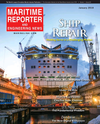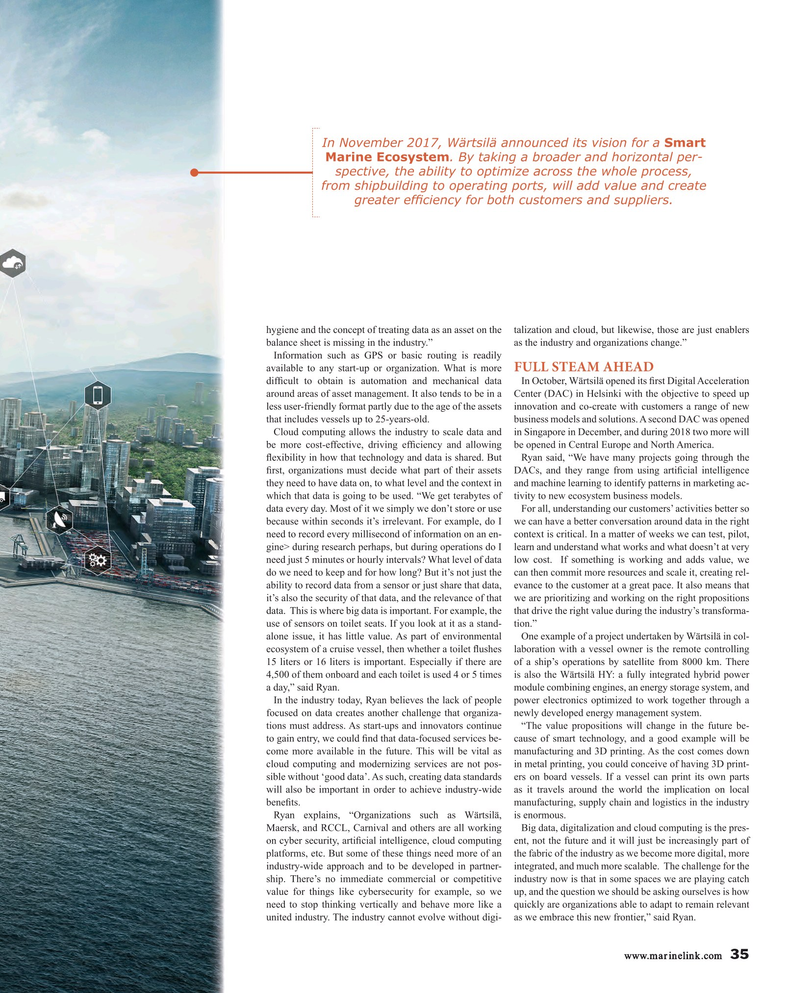
Page 35: of Maritime Reporter Magazine (January 2018)
Ship Repair & Conversion
Read this page in Pdf, Flash or Html5 edition of January 2018 Maritime Reporter Magazine
In November 2017, Wärtsilä announced its vision for a Smart
Marine Ecosystem. By taking a broader and horizontal per- spective, the ability to optimize across the whole process, from shipbuilding to operating ports, will add value and create greater ef? ciency for both customers and suppliers. hygiene and the concept of treating data as an asset on the talization and cloud, but likewise, those are just enablers balance sheet is missing in the industry.” as the industry and organizations change.”
Information such as GPS or basic routing is readily available to any start-up or organization. What is more FULL STEAM AHEAD dif? cult to obtain is automation and mechanical data In October, Wärtsilä opened its ? rst Digital Acceleration around areas of asset management. It also tends to be in a Center (DAC) in Helsinki with the objective to speed up less user-friendly format partly due to the age of the assets innovation and co-create with customers a range of new that includes vessels up to 25-years-old. business models and solutions. A second DAC was opened
Cloud computing allows the industry to scale data and in Singapore in December, and during 2018 two more will be more cost-effective, driving ef? ciency and allowing be opened in Central Europe and North America. ? exibility in how that technology and data is shared. But Ryan said, “We have many projects going through the ? rst, organizations must decide what part of their assets DACs, and they range from using arti? cial intelligence they need to have data on, to what level and the context in and machine learning to identify patterns in marketing ac- which that data is going to be used. “We get terabytes of tivity to new ecosystem business models. data every day. Most of it we simply we don’t store or use For all, understanding our customers’ activities better so because within seconds it’s irrelevant. For example, do I we can have a better conversation around data in the right need to record every millisecond of information on an en- context is critical. In a matter of weeks we can test, pilot, gine> during research perhaps, but during operations do I learn and understand what works and what doesn’t at very need just 5 minutes or hourly intervals? What level of data low cost. If something is working and adds value, we do we need to keep and for how long? But it’s not just the can then commit more resources and scale it, creating rel- ability to record data from a sensor or just share that data, evance to the customer at a great pace. It also means that it’s also the security of that data, and the relevance of that we are prioritizing and working on the right propositions data. This is where big data is important. For example, the that drive the right value during the industry’s transforma- use of sensors on toilet seats. If you look at it as a stand- tion.” alone issue, it has little value. As part of environmental One example of a project undertaken by Wärtsilä in col- ecosystem of a cruise vessel, then whether a toilet ? ushes laboration with a vessel owner is the remote controlling 15 liters or 16 liters is important. Especially if there are of a ship’s operations by satellite from 8000 km. There 4,500 of them onboard and each toilet is used 4 or 5 times is also the Wärtsilä HY: a fully integrated hybrid power a day,” said Ryan. module combining engines, an energy storage system, and
In the industry today, Ryan believes the lack of people power electronics optimized to work together through a focused on data creates another challenge that organiza- newly developed energy management system.
tions must address. As start-ups and innovators continue “The value propositions will change in the future be- to gain entry, we could ? nd that data-focused services be- cause of smart technology, and a good example will be come more available in the future. This will be vital as manufacturing and 3D printing. As the cost comes down cloud computing and modernizing services are not pos- in metal printing, you could conceive of having 3D print- sible without ‘good data’. As such, creating data standards ers on board vessels. If a vessel can print its own parts will also be important in order to achieve industry-wide as it travels around the world the implication on local bene? ts. manufacturing, supply chain and logistics in the industry
Ryan explains, “Organizations such as Wärtsilä, is enormous.
Maersk, and RCCL, Carnival and others are all working Big data, digitalization and cloud computing is the pres- on cyber security, arti? cial intelligence, cloud computing ent, not the future and it will just be increasingly part of platforms, etc. But some of these things need more of an the fabric of the industry as we become more digital, more industry-wide approach and to be developed in partner- integrated, and much more scalable. The challenge for the ship. There’s no immediate commercial or competitive industry now is that in some spaces we are playing catch value for things like cybersecurity for example, so we up, and the question we should be asking ourselves is how need to stop thinking vertically and behave more like a quickly are organizations able to adapt to remain relevant united industry. The industry cannot evolve without digi- as we embrace this new frontier,” said Ryan.
www.marinelink.com 35
MR #1 (34-41).indd 35 MR #1 (34-41).indd 35 1/10/2018 9:36:40 AM1/10/2018 9:36:40 AM

 34
34

 36
36
